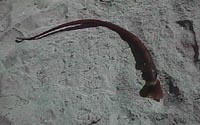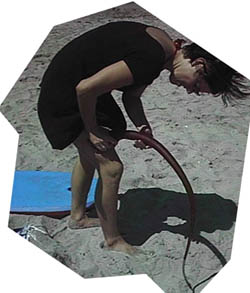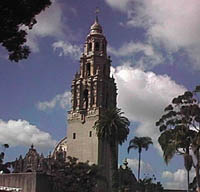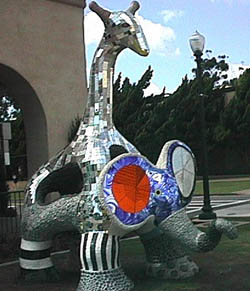|
|
|
commercial versus public
Friday, September 25 1998
Hansel and Gretel decided the witch's gingerbread house was too small and expensive, so they set off for the beach to find a gingerbread house of their own. Miraculously, they found one within a matter of days. One day they met with John the caretaker and signed the lease. John was one of those mechanically friendly military types, not the kind with whom Hansel and Gretel would normally associate; he was instead the kind who makes for a vigilant and slightly fussy landlord. Unexpectedly Hansel and Gretel discovered they were signing the lease for a drug-free gingerbread house, but we all know rules only apply to those who flaunt their disobedience.
They ventured to the south, to explore Balboa Park just northeast of downtown San Diego.

I frame the beach horizon with my arm, something Kim thought would be good to photograph.

A large seaweed stalk from "a dead mermaid," what I call human-sized clumps of seaweed that wash up on the shore. They stay afloat using air-filled bladders, some as large as baseballs.

The seaweed stalk looked like some sort of alien parasitic organism, and here Kim poses with it attached to her leg.

Our new place in Ocean Beach. It's one of the little townhouse-type cottages in the middle of this picture.

A beautiful Spanish tower on one of the museums in Balboa Park.

One of the strange mixed-media sculptures in the middle of Balboa Park. Rita says the artist who made these is named Ms. St. Phalle.

A commercial sculpture garden in Balboa Park. Unlike the museum space, this courtyard is free and open to the public, in hopes that they'll buy something. But it's very low-key commercialism.
Balboa Park is located on the site of two world expositions and definitely looks as though no expense was spared in its creation. Everything is exquisite: the Spanish architecture, the gardening, the landscaping, and attention to details. (Rita told me later that when they were originally erected, most of the Balboa Park structures were built with cheap materials designed to look good for a few months, but that over time most of the buildings have been renovated with more robust materials.) Walking past the buildings on the outside, it had the overall feel of a college campus. There's an inherent similarity among large non-commercial projects. It's an understated grandness, an anti-flamboyant showiness, a displaying of money without at the same time trying to separate people from it, a deliberate and obvious appeal to the highest virtues of humanity. "It's very Public Radio!" I remarked.
Of course, I'm from the East Coast and am more familiar with the Smithsonian Institution than I am with places of this sort. In Washington DC, it better serves those who govern us to give away access to the museums. Magnanimous generosity to one's immediate neighbors is usually a good policy for a wealthy resident to follow. In San Diego, though, Balboa Park and its many museums are not magnanimous to such an extreme. On certain Tuesdays, certain museums are free, but other than that, you have to pay to get in. Given our present financial situation, Kim and I decided it would be better to just walk around and take in the architecture and other things we could get for free.
One of the most spectacular of the free places was a domed building containing a botanical garden. Its roof was a basketlike web of rust-red metal ribbons, letting in air, rain and sunlight upon the mostly tropical plants in the collection. It occurred to me that this might be a good place to come to find models for the vegetation I like to incorporate in my paintings. Then it also occurred to me that there is a lot of money flowing around in these museums, carried in the pockets of the mostly-affluent visitors, but without the outstretched hands of commercialism to take it from them. If I set up shop and started painting pictures here, it would be a great way to meet possible buyers of my art. A small trace of commercialism goes far in a place like this. People in this environment get all psyched to buy things by their exposure to many precious things not for sale, created by folks who are mostly dead. (It's a known fact that people want to spend their money.) Then the wealthy visitor sees me, the starving artist, scratching out something beautiful, and out comes the dough (or so the theory goes).
But actually there was commercialism here, though of the extremely low-key kind. There were restaurants that seamlessly blended into the architecture, and there were little side-galleries where real live artists were making sculptures and other works and displaying them in museum-like settings. I have no idea how these artists came to be able to work here, but I suspect that they experience brisk trade.
The only trace of tacky commercialism was the occasional card table set up by a palm reader. But there was no hard sale, there was no hassling. This wasn't Mexico, where (as I recently learned) there is no place free of commercial intrusion from every strata of capitalism.
For linking purposes this article's URL is:
http://asecular.com/blog.php?980925 feedback
previous | next |






